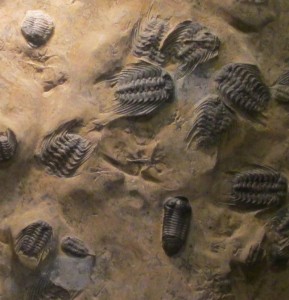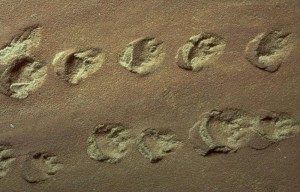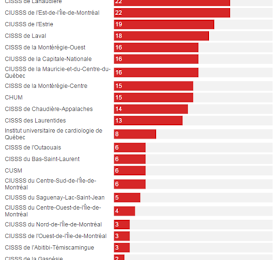(Image from Wikipedia: credit)
The story told by the fossils is one of great age, with a succession of flora and fauna in the distinct layers of sedimentary rock. Part three of the new book The Grand Canyon, Monument to an Ancient Earth: Can Noah’s Flood Explain the Grand Canyon? describes the fossils found in the Grand Canyon layers, and in the Grand Staircase layers above the current canyon plateau. This is a massive stretch of sedimentary rocks, according to modern geology spanning about 500 million years, from the Cambrian through the Mesozoic eras and up to the modern day. Flood geology as proposed by at least some Young Earth Creationists places all this deposition and most of the subsequent erosion within a very short time – as little as one year for the deposition and certainly no more than 2000 years for all deposition and erosion, from the tilted Precambrian “Supergroup” layers below the canyon to the current top of the staircase. In fact, many place all of the layers below the great unconformity as pre-flood, the tilting of these layers as early flood and the deposition up to Bryce Canyon as late flood, the major erosion is early post flood as waters drain (i.e. most of this shaping of the land occurred within one to two years), with modest erosion continuing through to the present. An image by the National Park Service, available at Wikipedia (source) illustrates these layers. The Precambrian Grand Canyon Supergroup is represented by the tilted layers near the canyon in the yellow Precambrian rock. More than two miles of sedimentary rock was deposited and hardened above the Precambrian layer.
 The fossils contained in the multiple layers of sedimentary rock tell a story – not a story consistent with a massive catastrophic flood. A summary of Grand Canyon Fossils is found on the park website here. It is common to point to the faunal succession, that is the layering of animal fossils as evidence for many layers over along period of time. Ralphy Stearly, a paleontologist by training and Professor of Geology at Calvin College, has written a nice description of the faunal succession in chapter 13. These range from trilobites and other “simpler” creatures in the lowest layers to dinosaur bones near Bryce Canyon at the top of the formation. (The image of trilobites to the right is one I took – and is not specifically from the Grand Canyon.) Although the layers provide witness to a succession of increasing complexity, it is important to remember that so-called “simple” creatures are found in many layers. Sponges are found in Cambrian layers, and in subsequent layers characteristic of marine environments. And, of course, sponges are found in the oceans today. But rabbits and dinosaurs, for example, are not found in the Cambrian layers. The fossils are found in communities representing different environments – fresh water, marine, swamp, sandy desert. Hydrodynamic sorting is often invoked to explain the layering observed, with earthquake sorting as another mechanism. These explanations are not convincing, except to the one who is already convinced that the global flood must explain the layers.
The fossils contained in the multiple layers of sedimentary rock tell a story – not a story consistent with a massive catastrophic flood. A summary of Grand Canyon Fossils is found on the park website here. It is common to point to the faunal succession, that is the layering of animal fossils as evidence for many layers over along period of time. Ralphy Stearly, a paleontologist by training and Professor of Geology at Calvin College, has written a nice description of the faunal succession in chapter 13. These range from trilobites and other “simpler” creatures in the lowest layers to dinosaur bones near Bryce Canyon at the top of the formation. (The image of trilobites to the right is one I took – and is not specifically from the Grand Canyon.) Although the layers provide witness to a succession of increasing complexity, it is important to remember that so-called “simple” creatures are found in many layers. Sponges are found in Cambrian layers, and in subsequent layers characteristic of marine environments. And, of course, sponges are found in the oceans today. But rabbits and dinosaurs, for example, are not found in the Cambrian layers. The fossils are found in communities representing different environments – fresh water, marine, swamp, sandy desert. Hydrodynamic sorting is often invoked to explain the layering observed, with earthquake sorting as another mechanism. These explanations are not convincing, except to the one who is already convinced that the global flood must explain the layers.
But the layered remains of animals, while the most evident in the popular literature, are not the most convincing fossil evidence for an ancient earth with the Grand Staircase layers testifying to a succession of life forms and environments. Even more convincing is the floral succession and the trace fossils left behind by various animals. Joel Duff (Professor of Biology at the University of Akron) provides a chapter on the floral fossils while David Elliot (Professor of Geology Northern Arizona University) outlines the evidence provided by trace fossils in chapter 15.
 Floral Succession. The Grand Staircase environment was marine in the Cambrian and Devonian eras, thus no terrestrial plants are found. In the Cambrian layers world wide only algae and fungi (lichen) are found on land. Mosses, horsetails and some other simple land plants are found in Devonian layers. The Mississippian and Pennsylvanian periods (359-259 mya according to modern geology) are characterized by the presence of ferns and horsetails and other nonflowering, nonconifers vascular plants. Some are found in the canyon layers, providing evidence for transition from a marine environment to a land environment. The current upper layers of the Grand Canyon correspond to these periods. Above the Grand Canyon conifers (cone producing plants) appear in the Permian (259 to 252 mya according to modern geology). Flowering plants don’t appear until the Jurassic period and don’t become common until the Cretaceous. Remains of flowering plants are not found in the Grand Canyon layers. (image source)
Floral Succession. The Grand Staircase environment was marine in the Cambrian and Devonian eras, thus no terrestrial plants are found. In the Cambrian layers world wide only algae and fungi (lichen) are found on land. Mosses, horsetails and some other simple land plants are found in Devonian layers. The Mississippian and Pennsylvanian periods (359-259 mya according to modern geology) are characterized by the presence of ferns and horsetails and other nonflowering, nonconifers vascular plants. Some are found in the canyon layers, providing evidence for transition from a marine environment to a land environment. The current upper layers of the Grand Canyon correspond to these periods. Above the Grand Canyon conifers (cone producing plants) appear in the Permian (259 to 252 mya according to modern geology). Flowering plants don’t appear until the Jurassic period and don’t become common until the Cretaceous. Remains of flowering plants are not found in the Grand Canyon layers. (image source)
But the most persuasive evidence is not from the macroscopic remains of plants, but from the fossilized pollen and spores found in the sedimentary rock.
Pollen and spores are microscopic reproductive products of plants that, due to their environmentally resistant outer walls, are among the most easily fossilized living structures. Spores are typically, but not always, larger than pollen grains and can be thought of as the “seeds” of ferns, lycopods, and mosses. Pollen is the male sex cell of flowering plants and gymnosperms (cone-bearing plants such as pine and spruce trees). (p. 149)
Pollen and spores demonstrate the same principle of floral succession in the Grand Canyon and Grand Staircase that the macrofossils do. Cambrian and Devonian rocks, represented by strata from the Tapeats Sandstone up to the Temple Butte Formation, contain only simple trilete (three-lobed) spores, which were generated from now-extinct simple spore-bearing plants and algae. Unmistakable spores from lycopods and ferns are plentiful in rocks above the Temple Butte Formation. … These spores are associated with the plant remains of ferns and horsetails (Calamites) and giant lycophyte trees (Lepidodendron).
Fossil pollen from conifer-like (non-flowering) trees (Cordaites) is first encountered in the upper rock formations of the canyon. … Conifers are the dominant plants in the Grand Staircase, and their pollen is readily distinguishable from flowering-plant pollen.
Significantly, the absence of any macroscopic fossils of flowering plants in Grand Canyon rock layers in matched by a complete absence of fossil flowering-plant pollen. (p. 150)
Both macroscopic and microscopic (pollen) fossils of flowering-plants are found in the upper layers of the Grand Staircase dating to the Cretaceous period. This sequence of floral succession in the rocks of the Grand Canyon and Grand Staircase is not consistent with a massive flood over the region. Any kind of sorting based on size would not segregate fossilized pollen, spores, and plants in this well attested pattern. In addition, Genesis attests to seed bearing plants before the flood. Then God said, “Let the land produce vegetation: seed-bearing plants and trees on the land that bear fruit with seed in it, according to their various kinds.” And it was so. (1:11), Then God said, “I give you every seed-bearing plant on the face of the whole earth and every tree that has fruit with seed in it. (1:29) That fossil remnants of seed-bearing plants are only found in the uppermost layers of the Grand Staircase should be a cause for rethinking the flood scenario. It simply does not work. Pollen and spores should certainly be mixed among the layers with the pollen of flowering plants present in all layers.
 Trace Fossils. The final fossil form found in the Grand Canyon and Grand Staircase is the trace fossil. Rather than fossilized structures of plants and animals, these are tracks or traces that remain, demonstrating that an animal or plant of some short lived in the past (image source). The image of a fern above is also a trace fossil – an imprint of a fern. Many kinds of trace fossils are found, with those in the Coconino Sandstone a good illustration. The tracks in the image are from this sandstone deposit.
Trace Fossils. The final fossil form found in the Grand Canyon and Grand Staircase is the trace fossil. Rather than fossilized structures of plants and animals, these are tracks or traces that remain, demonstrating that an animal or plant of some short lived in the past (image source). The image of a fern above is also a trace fossil – an imprint of a fern. Many kinds of trace fossils are found, with those in the Coconino Sandstone a good illustration. The tracks in the image are from this sandstone deposit.
Although no actual remains of organisms have been found in the Coconino Sandstone, the traces of animals and their behavior have been preserved as footprints and burrows in the sand. These traces range from large to small vertebrate tracks and also include tracks and burrows very similar to those left by spiders, scorpions, millipedes, and other arthropods in modern desert environments. The Coconino Sandstone contains no evidence of aquatic organisms of any kind that might support an argument for deposition in a deepwater, flood environment, such as has been proposed by flood geologists. (p. 154)
The sand at the back of each step in the image above indicates that the animal was moving up the sloping face of a sand dune. The fine claw marks, and many even more detailed features of other track of other animals demonstrate that these were produced and hardened in a dry environment with only a little moisture in the sand to hold the track. These are inconsistent with any flood scenario. They are consistent with traces left in sand today (albeit not (yet) hardened into rock).
Elliot concludes:
Taken as a whole, the sedimentary and trace fossil evidence clearly and unambiguously points toward a desert environment for the Coconino Sandstone. Although flood geologists claim that this sandstone was deposited in rapidly flowing water that was hundreds of feet deep, the presence of raindrop impressions, desiccation cracks, … and the preservation of footprints, are all clear indicators of a sand desert. Asserting an aquatic environment for the Coconino Sandstone requires ignoring nearly all of the geological and paleontological evidence. Truly, as one flood geologist has said, “I wouldn’t have seen it if I hadn’t believed it.” (p. 154)
More could be said about the story these fossils tell. The three chapters in part three of The Grand Canyon, Monument to an Ancient Earth only provide an introduction, and I have provided only a brief sketch of the chapters. But this should be enough to introduce the interested layperson to the reasons why the vast majority of Christians with training in geology and paleontology find the evidence for an old earth convincing. If you are interested, pick up a copy of the book and read the chapters complete with a multitude of illustrations. This isn’t direct evidence for evolution (although it is consistent with evolution). The point is that many plants and animals left readily observed traces in a clear faunal and floral succession, in multiple communities occupying very different environments. These fossils are found in distinct successive layers in the Grand Canyon and Grand Staircase. This is not consistent with a young earth or with flood geology.
If you wish to contact me directly you may do so at rjs4mail[at]att.net
If interested you can subscribe to a full text feed of my posts at Musings on Science and Theology.






